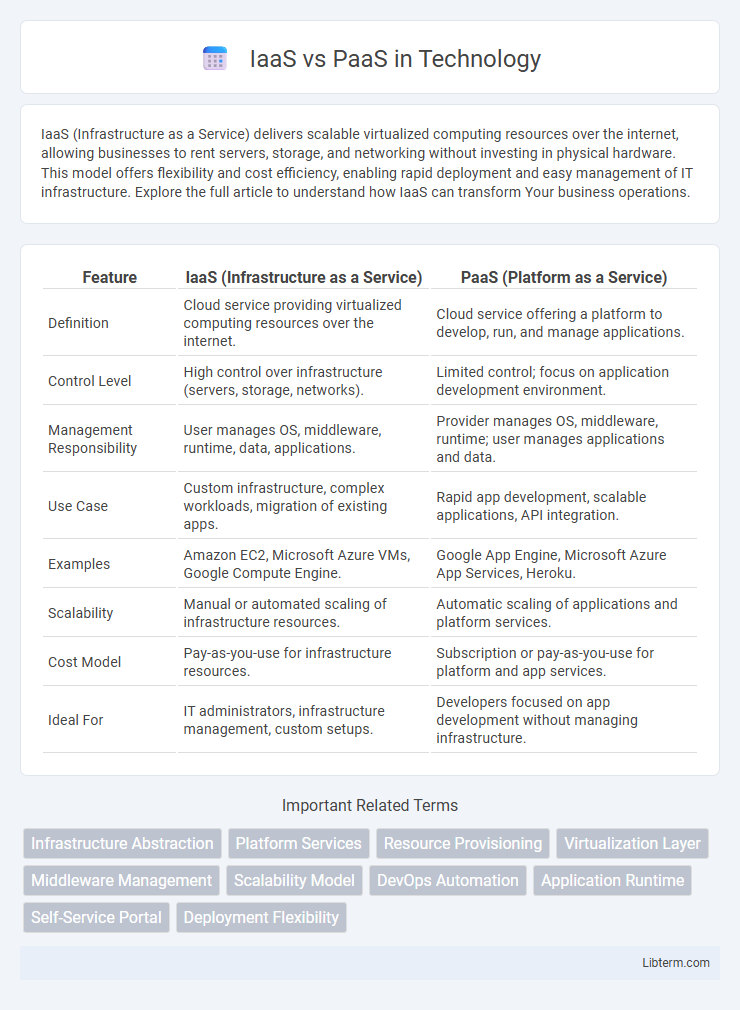IaaS (Infrastructure as a Service) delivers scalable virtualized computing resources over the internet, allowing businesses to rent servers, storage, and networking without investing in physical hardware. This model offers flexibility and cost efficiency, enabling rapid deployment and easy management of IT infrastructure. Explore the full article to understand how IaaS can transform Your business operations.
Table of Comparison
| Feature | IaaS (Infrastructure as a Service) | PaaS (Platform as a Service) |
|---|---|---|
| Definition | Cloud service providing virtualized computing resources over the internet. | Cloud service offering a platform to develop, run, and manage applications. |
| Control Level | High control over infrastructure (servers, storage, networks). | Limited control; focus on application development environment. |
| Management Responsibility | User manages OS, middleware, runtime, data, applications. | Provider manages OS, middleware, runtime; user manages applications and data. |
| Use Case | Custom infrastructure, complex workloads, migration of existing apps. | Rapid app development, scalable applications, API integration. |
| Examples | Amazon EC2, Microsoft Azure VMs, Google Compute Engine. | Google App Engine, Microsoft Azure App Services, Heroku. |
| Scalability | Manual or automated scaling of infrastructure resources. | Automatic scaling of applications and platform services. |
| Cost Model | Pay-as-you-use for infrastructure resources. | Subscription or pay-as-you-use for platform and app services. |
| Ideal For | IT administrators, infrastructure management, custom setups. | Developers focused on app development without managing infrastructure. |
Introduction to IaaS and PaaS
Infrastructure as a Service (IaaS) provides virtualized computing resources over the internet, offering scalable infrastructure such as servers, storage, and networking on demand. Platform as a Service (PaaS) delivers a managed environment for developing, testing, and deploying applications, including runtime, middleware, and development tools, without managing the underlying hardware. IaaS excels in flexibility and control over infrastructure, while PaaS streamlines application development and accelerates time-to-market by abstracting infrastructure management.
What is IaaS? Key Features and Benefits
IaaS (Infrastructure as a Service) delivers virtualized computing resources over the internet, including servers, storage, and networking, enabling scalable and flexible IT infrastructure management. Key features include on-demand resource provisioning, automated scalability, and pay-as-you-go pricing, which reduce capital expenses and increase operational agility. The primary benefits of IaaS are improved disaster recovery, enhanced business continuity, and the ability to quickly deploy and manage workloads without investing in physical hardware.
What is PaaS? Key Features and Benefits
Platform as a Service (PaaS) is a cloud computing model that provides developers with a ready-to-use platform, including operating systems, middleware, and development tools, enabling rapid application development and deployment. Key features of PaaS include automated infrastructure management, integrated development environments (IDEs), scalability, and built-in security protocols. Benefits of PaaS encompass accelerated time-to-market, reduced infrastructure costs, effortless collaboration, and seamless integration with third-party services and APIs.
IaaS vs PaaS: Core Differences
IaaS (Infrastructure as a Service) provides virtualized computing resources such as servers, storage, and networking, offering maximum control over hardware and operating systems. PaaS (Platform as a Service) delivers a managed environment for application development, including runtime, middleware, and development tools, abstracting infrastructure management. The core difference lies in IaaS offering foundational infrastructure flexibility, while PaaS emphasizes streamlined application deployment and development efficiency.
Use Cases for IaaS
IaaS (Infrastructure as a Service) is ideal for businesses needing scalable computing resources like virtual machines, storage, and networking without investing in physical hardware. Common use cases include hosting websites, running large-scale data analysis, disaster recovery solutions, and development/testing environments where control over infrastructure configuration is crucial. Enterprises use IaaS to achieve flexible resource management, rapid scaling, and cost savings by paying only for the infrastructure they consume.
Use Cases for PaaS
PaaS (Platform as a Service) enables developers to build, test, and deploy applications rapidly without managing underlying infrastructure, making it ideal for software development and collaborative projects. Use cases include application hosting, API development, and integration, as well as streamlining DevOps workflows with automated tools and container orchestration. Enterprises leverage PaaS to accelerate time-to-market for custom applications while ensuring scalability and reducing operational complexity.
Pros and Cons of IaaS
IaaS (Infrastructure as a Service) offers scalable virtualized computing resources, giving businesses full control over their IT infrastructure with flexible storage, networking, and server options. Its pros include cost efficiency through pay-as-you-go pricing, high customization, and the ability to quickly provision resources. However, IaaS requires significant management effort and technical expertise, can lead to security vulnerabilities if not properly configured, and may involve complex scaling challenges compared to PaaS solutions.
Pros and Cons of PaaS
PaaS offers streamlined application development with built-in tools, reducing time to market and simplifying infrastructure management, which benefits developers who want to focus on coding rather than server maintenance. However, PaaS may limit customization options and create vendor lock-in risks due to reliance on the provider's platform and integrations. Scalability is easy with PaaS, but potential performance constraints and less control over underlying resources can be drawbacks for complex or highly specialized applications.
Choosing Between IaaS and PaaS: Key Considerations
Choosing between Infrastructure as a Service (IaaS) and Platform as a Service (PaaS) depends on the level of control, customization, and management responsibility desired by the user. IaaS provides virtualized computing resources like servers and storage, offering maximum flexibility for enterprises needing full control over their IT infrastructure. PaaS delivers a managed environment with pre-configured development tools and runtime, ideal for developers focusing on application deployment without managing underlying hardware.
Future Trends in Cloud Infrastructure Platforms
IaaS and PaaS are evolving rapidly, with future trends emphasizing increased automation, AI integration, and edge computing capabilities. Cloud providers are focusing on enhancing scalability and security through containerization and serverless architectures within both IaaS and PaaS models. The convergence of hybrid and multi-cloud strategies is driving enterprises to adopt more flexible, cost-efficient platform solutions that optimize workload performance and management.
IaaS Infographic

 libterm.com
libterm.com